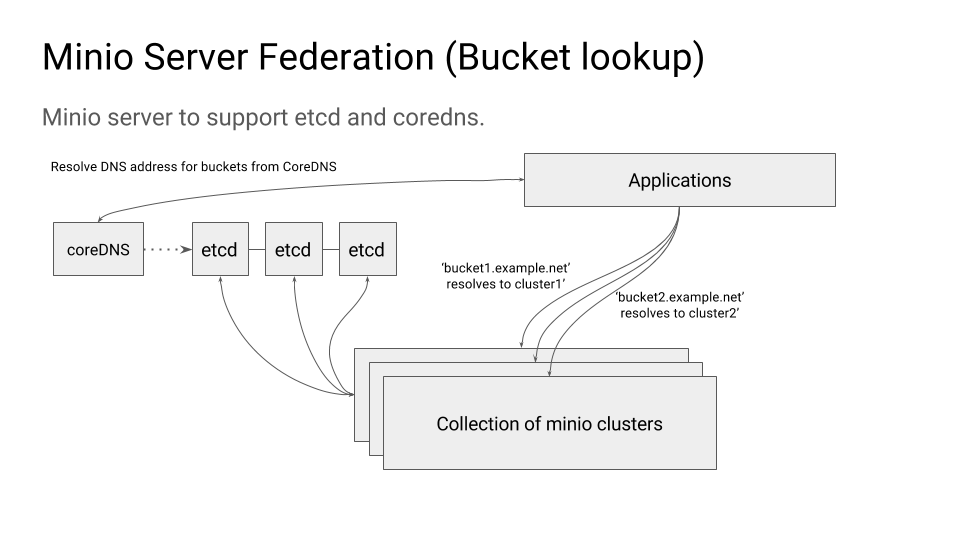mirror of https://github.com/minio/minio.git
88 lines
4.0 KiB
Markdown
88 lines
4.0 KiB
Markdown
# Federation Quickstart Guide [](https://slack.min.io) *Federation feature is deprecated and should be avoided for future deployments*
|
||
|
||
This document explains how to configure MinIO with `Bucket lookup from DNS` style federation.
|
||
|
||
## Get started
|
||
|
||
### 1. Prerequisites
|
||
|
||
Install MinIO - [MinIO Quickstart Guide](https://docs.min.io/docs/minio-quickstart-guide).
|
||
|
||
### 2. Run MinIO in federated mode
|
||
|
||
Bucket lookup from DNS federation requires two dependencies
|
||
|
||
- etcd (for bucket DNS service records)
|
||
- CoreDNS (for DNS management based on populated bucket DNS service records, optional)
|
||
|
||
## Architecture
|
||
|
||

|
||
|
||
### Environment variables
|
||
|
||
#### MINIO_ETCD_ENDPOINTS
|
||
|
||
This is comma separated list of etcd servers that you want to use as the MinIO federation back-end. This should
|
||
be same across the federated deployment, i.e. all the MinIO instances within a federated deployment should use same
|
||
etcd back-end.
|
||
|
||
#### MINIO_DOMAIN
|
||
|
||
This is the top level domain name used for the federated setup. This domain name should ideally resolve to a load-balancer
|
||
running in front of all the federated MinIO instances. The domain name is used to create sub domain entries to etcd. For
|
||
example, if the domain is set to `domain.com`, the buckets `bucket1`, `bucket2` will be accessible as `bucket1.domain.com`
|
||
and `bucket2.domain.com`.
|
||
|
||
#### MINIO_PUBLIC_IPS
|
||
|
||
This is comma separated list of IP addresses to which buckets created on this MinIO instance will resolve to. For example,
|
||
a bucket `bucket1` created on current MinIO instance will be accessible as `bucket1.domain.com`, and the DNS entry for
|
||
`bucket1.domain.com` will point to IP address set in `MINIO_PUBLIC_IPS`.
|
||
|
||
- This field is mandatory for standalone and erasure code MinIO server deployments, to enable federated mode.
|
||
- This field is optional for distributed deployments. If you don't set this field in a federated setup, we use the IP addresses of
|
||
hosts passed to the MinIO server startup and use them for DNS entries.
|
||
|
||
### Run Multiple Clusters
|
||
|
||
> cluster1
|
||
|
||
```sh
|
||
export MINIO_ETCD_ENDPOINTS="http://remote-etcd1:2379,http://remote-etcd2:4001"
|
||
export MINIO_DOMAIN=domain.com
|
||
export MINIO_PUBLIC_IPS=44.35.2.1,44.35.2.2,44.35.2.3,44.35.2.4
|
||
minio server http://rack{1...4}.host{1...4}.domain.com/mnt/export{1...32}
|
||
```
|
||
|
||
> cluster2
|
||
|
||
```sh
|
||
export MINIO_ETCD_ENDPOINTS="http://remote-etcd1:2379,http://remote-etcd2:4001"
|
||
export MINIO_DOMAIN=domain.com
|
||
export MINIO_PUBLIC_IPS=44.35.1.1,44.35.1.2,44.35.1.3,44.35.1.4
|
||
minio server http://rack{5...8}.host{5...8}.domain.com/mnt/export{1...32}
|
||
```
|
||
|
||
In this configuration you can see `MINIO_ETCD_ENDPOINTS` points to the etcd backend which manages MinIO's
|
||
`config.json` and bucket DNS SRV records. `MINIO_DOMAIN` indicates the domain suffix for the bucket which
|
||
will be used to resolve bucket through DNS. For example if you have a bucket such as `mybucket`, the
|
||
client can use now `mybucket.domain.com` to directly resolve itself to the right cluster. `MINIO_PUBLIC_IPS`
|
||
points to the public IP address where each cluster might be accessible, this is unique for each cluster.
|
||
|
||
NOTE: `mybucket` only exists on one cluster either `cluster1` or `cluster2` this is random and
|
||
is decided by how `domain.com` gets resolved, if there is a round-robin DNS on `domain.com` then
|
||
it is randomized which cluster might provision the bucket.
|
||
|
||
### 3. Test your setup
|
||
|
||
To test this setup, access the MinIO server via browser or [`mc`](https://docs.min.io/docs/minio-client-quickstart-guide). You’ll see the uploaded files are accessible from the all the MinIO endpoints.
|
||
|
||
## Explore Further
|
||
|
||
- [Use `mc` with MinIO Server](https://docs.min.io/docs/minio-client-quickstart-guide)
|
||
- [Use `aws-cli` with MinIO Server](https://docs.min.io/docs/aws-cli-with-minio)
|
||
- [Use `s3cmd` with MinIO Server](https://docs.min.io/docs/s3cmd-with-minio)
|
||
- [Use `minio-go` SDK with MinIO Server](https://docs.min.io/docs/golang-client-quickstart-guide)
|
||
- [The MinIO documentation website](https://docs.min.io)
|